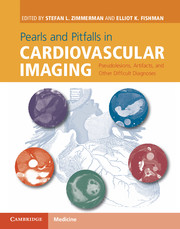 Pearls and Pitfalls in Cardiovascular Imaging
Pearls and Pitfalls in Cardiovascular Imaging from Section 6 - Cardiovascular MRI artifacts
Published online by Cambridge University Press: 05 June 2015
Imaging description
Time-of-flight (TOF) magnetic resonance angiography (MRA) images are prone to several artifacts that may suggest stenosis or occlusion of vascular segments. TOF MRA is based on the acquisition of 2D or 3D gradient echo images which are optimized to saturate protons in stationary tissues while maximizing flow-related enhancement from inflowing blood protons that enter the slice during the acquisition. Saturation bands are added to selectively null signal from venous or arterial blood that is flowing in the opposite direction of the vessel of interest. For example, if an image of the abdominal aorta is desired, a saturation band below the plane of interest is used to null inflowing venous blood from the inferior vena cava. Several well-known artifacts occur with TOF imaging. In-plane flow can result in pseudostenosis or artifactual occlusion because blood protons flowing within a vessel parallel to the imaging plane will become saturated during the acquisition (Figure 52.1). Slow-flowing blood may also become saturated before it reaches the end of the TOF slab, such that the distal vessel appears attenuated in luminal diameter and signal. Reversal of flow, which can occur due to retrograde filling with collateral arteries, will be undetectable with TOF techniques due to the use of saturation bands to suppress venous contamination (Figure 52.2). Susceptibility artifacts from surgical clips or adjacent hardware may attenuate the MR signal, and the gradient echo (GRE) sequences used for TOF are especially sensitive for this type of artifact. Finally, dephasing of protons that occurs due to turbulent flow at vessel bifurcations may mimic stenoses, while accelerated and turbulent flow at existing stenoses may lead to overestimation of the degree of stenosis.
Importance
TOF MRA is a widely used unenhanced MRA method. Knowledge of artifacts that may mimic vascular stenosis or occlusion is essential for accurate interpretation. Misinterpretation of the absence or presence of vascular stenosis or occlusion can lead to unnecessary intervention or surgery, or fail to diagnose a treatable cause for the patient's symptoms.
To save this book to your Kindle, first ensure no-reply@cambridge.org is added to your Approved Personal Document E-mail List under your Personal Document Settings on the Manage Your Content and Devices page of your Amazon account. Then enter the ‘name’ part of your Kindle email address below. Find out more about saving to your Kindle.
Note you can select to save to either the @free.kindle.com or @kindle.com variations. ‘@free.kindle.com’ emails are free but can only be saved to your device when it is connected to wi-fi. ‘@kindle.com’ emails can be delivered even when you are not connected to wi-fi, but note that service fees apply.
Find out more about the Kindle Personal Document Service.
To save content items to your account, please confirm that you agree to abide by our usage policies. If this is the first time you use this feature, you will be asked to authorise Cambridge Core to connect with your account. Find out more about saving content to Dropbox.
To save content items to your account, please confirm that you agree to abide by our usage policies. If this is the first time you use this feature, you will be asked to authorise Cambridge Core to connect with your account. Find out more about saving content to Google Drive.